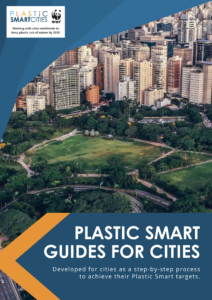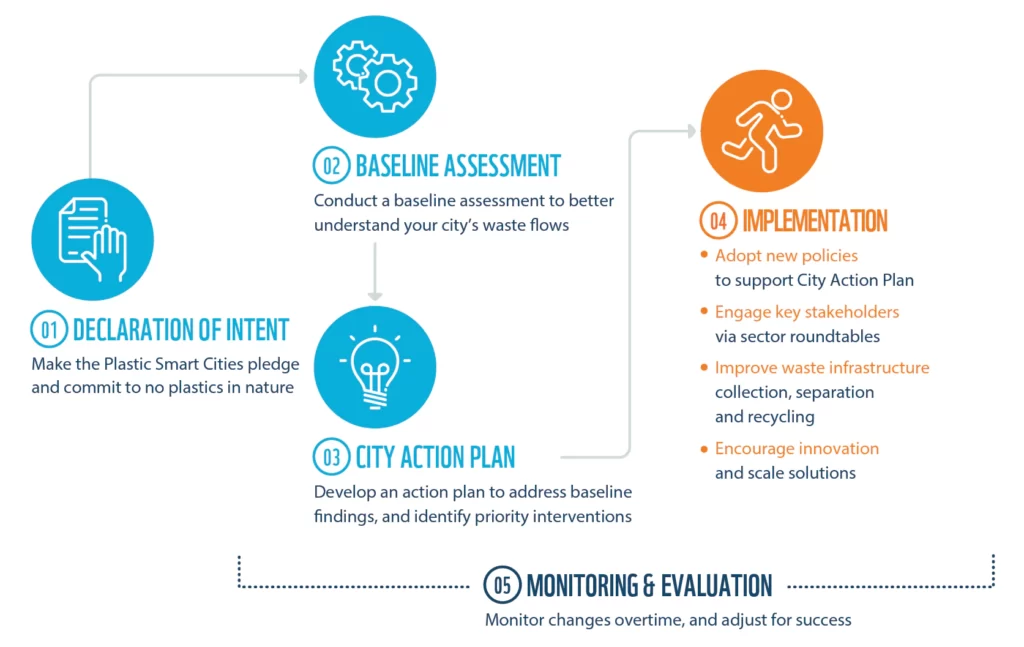City Action Plan
Develop an action plan with key stakeholders and put in place high-impact interventions to reduce plastic pollution.
This guidance outlines a city’s approach to developing an action plan, taking into account the findings of the Baseline Assessment, to identify priority interventions with high impact for reducing plastic pollution. Developing the City Action Plan should be an iterative process, involving consultations with key stakeholders, while remaining flexible to adapt as local situations change. Please see published PSC City Action Plans for best practices and guidance, as well as download the City Action Plan Template as a reference.
A well developed City Action Plan on plastic waste is critical to ensuring a sustainable, healthy, and inclusive global community.
First, we must take inventory by assessing our local waste stream (see Baseline Assessment), collecting hard data to guide our city strategy. Second, we must commit resources and develop a comprehensive strategy to educate, motivate and mandate – both individuals and industry – to adopt waste prevention strategies that reduce the volume of waste that must be collected and managed at the local level. Third, we must employ a scalable waste management program that adheres to the universal waste hierarchy, understanding that the largest initial gains in reducing pollution can often come from improving waste collection and processing methods.
As urban populations grow – estimated to account for two-thirds of the global population by 2050 – they must adopt smart solutions that reduce the collective impact of their prospering communities. This means preventing, minimizing and managing plastic waste, by adopting a comprehensive strategy that changes attitudes and behaviors through actions that educate, motivate and mandate, when necessary:
Educate through public awareness efforts to encourage behavioral change. Creating awareness among the general public as well as the business community is fundamental to changing behavior and attitudes about the way people consume resources and generate waste. Sharing practical information and guiding tools about how individuals or companies can prevent and reduce waste in their daily lives, is a critical first step.
Motivate through measures that incentivize change or disincentivize status-quo. Motivating strategies often provoke actions by incentivizing people to make behavioral changes that support waste prevention. The strongest stimulus is the polluter pays principle, which places all costs for the environmentally sound management of generated waste onto the waste generator. Fees, management prices, or appropriate schemes of Extended Producer Responsibility (EPR) are possible instruments.
Mandate change through regulatory action. Regulatory strategies addressing waste prevention can take many forms such as enforcing bans on the use of single-use plastics (strict avoidance) as well as imposing limits on the volume of waste generated (source reduction) by certain industrial activities. With industry at the helm of making design and production decisions that affect all other product life-cycle stages, industry is often a target for regulatory strategies. Sustainable design requirements, producer responsibility initiatives, environmental controls through permitting and take-back mandates are all examples of regulatory strategies.
A well developed City Action Plan will identify trends and key findings from the Baseline Assessment, it will include an overview of the city’s priority activities and interventions (see Best Practices for case study examples), as well as an implementation timeline and key performance indicators for measuring changes over time (see Monitoring and Evaluation guide).
As city stakeholders develop a comprehensive strategy and consider the various solutions available to them, a systematic approach for prioritizing actions should closely align with the Baseline findings:
1. Evaluate priority areas and solutions for implementation.
- Based on the findings of the baseline assessment, evaluate interventions that can effectively address the specific problem or need that has been prioritized, and assess solutions for Appropriateness-of-Fit and applicability
- Assess the Ease of Implementation given the time and resources needed, as well as the city’s regulatory and institutional capacity and financial strength and stability.
- Assess the Impact of the preferred solution on all sectors and all segments of the population, with consideration for social, economic and environmental impacts.
- Identify preferred solutions for implementation
2. Engage stakeholders and raise public awareness
- Engage stakeholders throughout the entire process of solution formulation, and encourage input from those that will be affected by the preferred solution, using evidence based studies to gain support
- Stakeholders may include retailers, consumers, industry representatives, government, manufacturers, civil society, environmental groups, tourism associations, among others
- Launch a public awareness campaign to clearly articulate the problem and related impacts, and build public support for the intervention prior to adoption and implementation
3. Encourage uptake of alternatives as may be applicable
- Ensure that alternatives promoted by the solution are widely available to all segments of the population, and that the conditions in the local market are adapted to encourage successful uptake
- Consider economic incentives to encourage use of alternatives while also supporting industry through the initial transition
- Incentives can include subsidies, tax rebates, discounts, etc.
Priority activities and interventions should align with the internationally recognized Waste Hierarchy, with prevention as a first priority placed at the top of the hierarchy, and with disposal at the bottom of the hierarchy, considered only as a last resort.
I. PLASTIC WASTE PREVENTION
Waste prevention depends fundamentally on changes in the attitudes and behavior of individuals and businesses, and on a transformative shift in industrial processes and product design. Waste prevention refers to practical actions that reduce the quantity of materials prior to materials and products becoming wastes.
Waste prevention is therefore fundamentally different from waste management activities, as waste management activities are implemented after materials become waste. Employing waste prevention strategies can effectively reduce the volume of waste that must be managed, placing less strain on local waste collection and management programs.
Waste prevention includes Avoidance – eliminating the need for a product or material; Source Reduction – eliminating waste and pollution at source through process changes; and Direct Re-use/Prolonging Use – extending product life, serving as a diversion of waste flows.
See the Plastic Smart Cities Prevention Best Practice catalogue for additional intervention opportunities.
II. PLASTIC WASTE COLLECTION
Half of the world’s population does not have access to waste management services. This is largely a result of constrained city budgets, as waste management can often consume 50% of a city’s total annual spend. While plastic waste represents a significant economic and environmental cost borne by cities and society as a whole, plastic waste is also a largely untapped opportunity.
Environmentally sound waste management is an opportunity to avoid the detrimental impacts associated with plastic waste in nature. It’s also an opportunity to recover valuable resources that can add environmental, economic and social benefits. Advanced waste management processes can reduce costs, create local jobs, protect public health and ecosystem vitality.
A core element of any waste management system is waste collection rates, which are ultimately dependent on local factors – governance, geography, population density, consumption patterns, public awareness, amongst others.
A staggering 90% of waste produced in low-income countries are openly dumped or burned. These same cities are growing at a rapid pace, but without adequate waste management systems in place, the ocean and our global coastlines will only serve as a dumping ground for yet more plastic debris. The imperative is for cities to develop waste management programs that increase collection rates and eliminate leakage during transport to reception facilities.
Waste management is a cooperative process that requires multi-stakeholder engagement – the City Government, businesses, NGOs, and individuals in the community all have an important responsibility to ensure environmentally sound waste management.
See the Plastic Smart Cities Collection Best Practice catalogue for additional intervention opportunities.
III. PLASTIC REUSE AND RECYCLING
Plastic production is expected to double over the next 20 years. According to the Ellen MacArthur Foundation, only 14% of plastic packaging is collected for recycling. Plastic packaging valued up to USD 120 billion annually is leaked into nature after a single-use. Increasing plastic collection rates is first and foremost, in order to recapture valuable materials for reuse and recycling. Developing second use markets and local recycling infrastructure can extract value from materials that are often discarded.
Reuse extends product and material life-cycles, to reduce the waste stream. Innovative reuse models can unlock significant benefits, enabled by digital technologies and shifting user preferences. Such models can help deliver a superior user experience, customize products to individual needs, gather user insights, build brand loyalty, optimize operations, and save costs.
See the Plastic Smart Cities Reuse and Recycling Best Practice catalogues for additional intervention opportunities.
IV. PLASTIC MONITORING AND EVALUATION
Monitoring local waste streams is critical to developing sound city strategies. Gathering hard data on the types of waste and volumes of waste that are generated can help the city design fitting waste management programs, allocate resources to ensure appropriate collection infrastructure and scheduling, establish short and long-term targets for collection and diversion, and adapt as consumption patterns evolve. With good data, cities can better assess relevant technologies, applicable best practices given the local context, and identify strategic partners for service provisions.
See the Plastic Smart Cities Baseline Assessment and Monitoring and Evaluation guides. Also see the Waste Flow Tools Best Practice catalogue for case study examples.
Plastic Smart Cities Framework
Follow the journey to becoming a Plastic Smart City.
Click on the steps below find out more about other steps in the framework.
Access the Plastic Smart Guide for Cities
Focused on how cities and local governments can start their journey on becoming plastic smart – complete with templates, actionable recommendations, as well as both framework and examples. Submit your information to access the Plastic Smart Guide.

